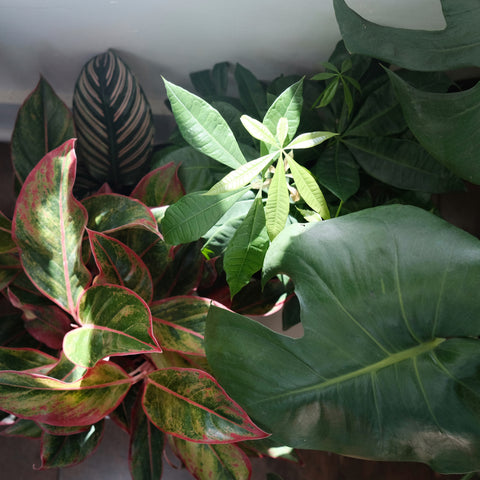Turning Over a New Leaf: Fall Houseplant Care Essentials
Hello and happy October! Mother Nature has been teasing us with little glimpses of fall weather, and we are so ready for it.
As the days grow shorter and temperatures begin to drop, it's time to start thinking about preparing your houseplants for the transition to fall weather. Just as we adjust our routines and wardrobes (hello boots and scarves!) for the changing seasons, our indoor green friends require some special care during this time. Let's walk through the essential steps to ensure your houseplants thrive through the fall.

1. Bringing Plants Inside
Nearly all of the plants at Bark & Vine are tropical plants, and as such don't like to be exposed to temperatures consistently below 60 degrees. As the chill of autumn sets in, many houseplants that have spent the summer outdoors should be brought back inside. Feel free to bring them in now, or when nighttime temps reach 55-60 degrees or below.
When transitioning your plants indoors, follow these steps:
a. Inspect for Pests: Before bringing your plants inside, examine them closely for any signs of pests. Isolate affected plants and treat them to prevent infestations from spreading indoors. Stop in to pick up a bottle of Captain Jack's, Neem Oil, or some Mosquito Bits. We've also got items for any fungal issues you might discover.

b. Repot if Necessary: If your plants have outgrown their pots during the summer, consider repotting them into slightly larger containers. Ensure the new pots have good drainage to prevent overwatering.
c. Quarantine New Additions: If you've acquired new plants during the summer, keep them separate from your existing collection for a few weeks to monitor for any signs of pests or diseases.
2. Adjusting Light Conditions
As fall progresses, daylight hours decrease, and the angle of sunlight changes. To accommodate your houseplants' changing light needs, follow these steps:
a. Monitor Light Levels: Pay attention to how the changing season affects the light in your home. Identify the best spots for your plants based on their light requirements. Move light-loving plants closer to windows or provide supplemental grow lights.
b. Rotate Your Plants: Periodically rotate your houseplants to ensure even growth. This helps prevent them from leaning or stretching toward the light source.
c. Trim Overgrown Growth: If your plants have become leggy over the summer, consider pruning them back to encourage bushier growth and a more attractive shape.

3. Adjusting Watering and Humidity
Fall typically brings lower humidity levels and decreased watering needs. To prevent overwatering and maintain an ideal environment for your houseplants:
a. Reduce Watering Frequency: With cooler temperatures and lower light levels, your plants will require less water. Be sure to adjust your watering schedule accordingly. Ask us for a care card when you're in the shop if you're unsure of what your plant needs!
b. Increase Humidity: As indoor heating systems kick in, the air in your home can become dry. To combat this, consider using a humidifier, placing a tray of water near your plants, or misting them frequently.

4. Stop Fertilizing
In the fall, most houseplants enter a period of dormancy or reduced growth. It's important to adjust your fertilization routine should you notice slowing growth.
a. Reduce Fertilization: As your plants' growth slows down, reduce or stop fertilizing altogether during the fall and winter months. Over-fertilizing during this time can lead to nutrient imbalances and stress for your plants.
Keep in mind there are exceptions, such as a blooming holiday cactus. Those flowers need nutrients to bloom! Ask us if you have any questions about rare or flowering plant nutrition needs through fall and winter.
b. Resume Fertilization in Spring: Resume regular fertilization in the spring when your plants begin to show signs of new growth.
By following these steps and adjusting your care routine to the changing seasons, you can ensure that your houseplants remain healthy and vibrant as they transition into the fall and prepare for the winter ahead.
Remember that each plant has unique needs, so closely monitoring their condition and adapting your care accordingly will lead to the best results. With a little extra attention, your indoor jungle will thrive through the fall and beyond.
Just getting into this houseplant thing? Take a peek at our blog written just for you - How to Start a Jungle - and come see us to start building your collection.
Happy autumn from all of us at Bark & Vine!
